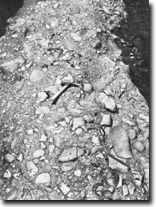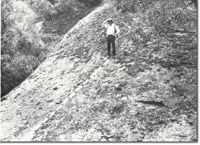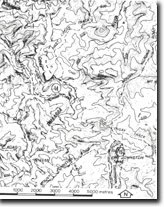8523-14 Wilkinson River Gorge
|
This information has been developed from the publications:
|
| Location: | 924555. North of the Timbarra River crossing of the Old Ensay Road. |  Wilkinson River Gorge. Conglomerates of the Timbarra Formation. |
Abstract: | River gorge cut in Timbarra Formation. | |
Access: | Old Ensay Road. | |
Ownership: | Crown land. | |
Geology: | The Snowy River Volcanics have been divided into seven formations, the oldest of which is the Timbarra Formation. This Formation is considered to underlie the main mass of the Snowy River Volcanics, although it may be contemporaneous with the Deddick Rhyodacite recognized to the north in the upper Snowy River area. The Timbarra Formation consists predominantly of conglomerates with minor intercalations of tuff, agglomerate, rhyodacite and fine grade sediments. This formation is well exposed in the Wilkinson River Gorge. The conglomerates contain clasts which vary in size from 0.5 cm to 75 cm. These consist of fine grained volcanics, quartzite, shale and occasional granite pebbles. Several broad, steeply plunging anticlines occur in the lower parts of the gorge. Erosion has exposed the folded structures, where these strike across the creek. The Timbarra Formation is down-faulted against steeply dipping Ordovician slates and sandstones to the south of the gorge but unconformably overlies the Ordovician sediments within the gorge. The Ordovician at this locality consists of vertically dipping slates and sandstones. | |
Geomorphology: | The Wilkinson Creek has cut a substantial gorge through the Timbarra Formation, with cliffs 30 m in height. The conglomerates are more resistant to erosion than the Ordovician sediments and consequently the gorge is best developed in the former material. Within the gorge, the stream channel is strewn with large conglomerate boulders which are often separated by deep pools. Cliff undercutting has produced landslides at several localities. | |
Significance: | Regional. Well developed gorge with the best exposure of Timbarra Formation in the region. | |
Management: | The gorge and the exposures of the Timbarra Formation would be obscured by flooding resulting from dam construction in the area. | |
References: | Ringwood, A.E. 1955b. 'The geology of the Snowy River district, East Gippsland', Ibid. 67 :67-74. Fletcher, K. 1963. 'The Snowy River Volcanics west of Buchan, Victoria', Proc. R. Soc. Vict. 76 :169-179. O’Shea, P.J. 1980. 'Mineral Potential of the Snowy River Volcanics and Buchan Caves Limestone', Rep. Geol. Surv. Vict., No.63. | |
 Wilkinson River Gorge. Plunging antiform in Timbarra Formation. Dotted line indicates possible axis trend. |



